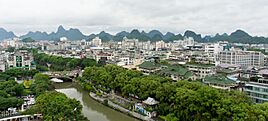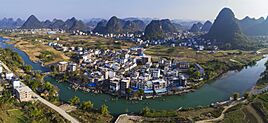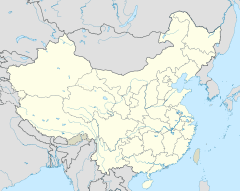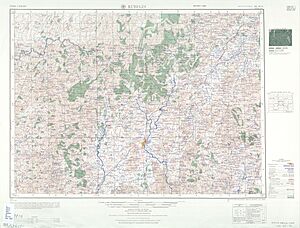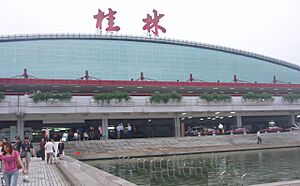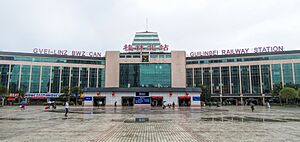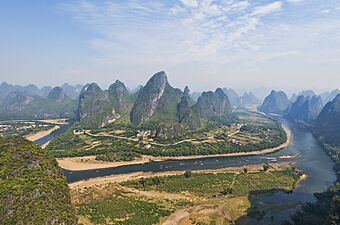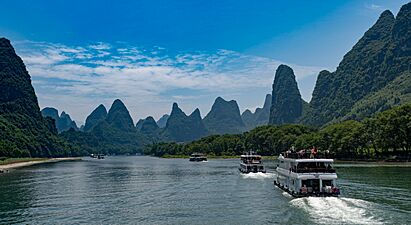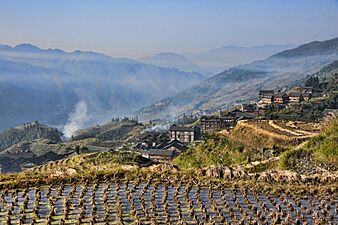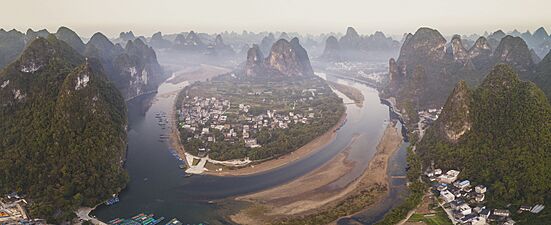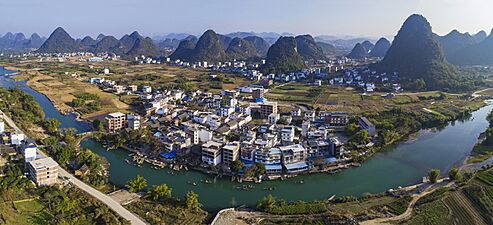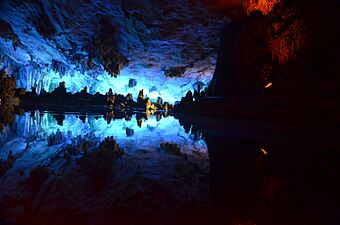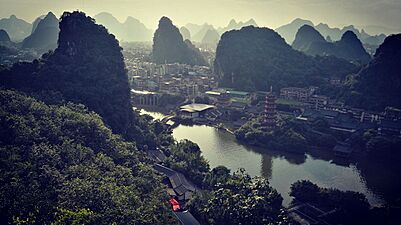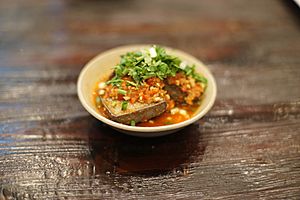Guilin facts for kids
Quick facts for kids
Guilin
桂林市 • Gveilinz Si
Kweilin
|
|
|---|---|
|
Prefecture-level city
|
|
|
From left to right, top to bottom: View of Guilin city; Elephant Trunk Hill, Sun and Moon Pagodas; Longsheng Rice Terraces, Jingjiang Princes' Palace, Reed Flute Cave; Yangshuo scenery
|
|
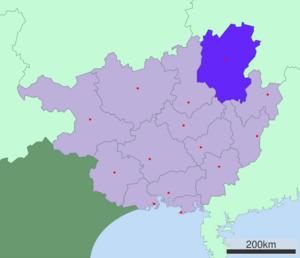
Location of Guilin City jurisdiction in Guangxi
|
|
| Country | People's Republic of China |
| Autonomous region | Guangxi |
| Area | |
| • Prefecture-level city | 27,797 km2 (10,732 sq mi) |
| • Urban | 2,753 km2 (1,063 sq mi) |
| • Metro | 5,041 km2 (1,946 sq mi) |
| Elevation | 153 m (502 ft) |
| Population
(2020 census)
|
|
| • Prefecture-level city | 4,931,137 |
| • Density | 177.398/km2 (459.459/sq mi) |
| • Urban | 1,725,865 |
| • Urban density | 626.90/km2 (1,623.67/sq mi) |
| • Metro | 2,148,641 |
| • Metro density | 426.23/km2 (1,103.94/sq mi) |
| GDP | |
| • Prefecture-level city | CN¥ 231.1 billion US$ 35.8 billion |
| • Per capita | CN¥ 46,767 US$ 7,249 |
| Time zone | UTC+8 (China Standard) |
| Postal code |
541XXX
|
| Area code(s) | 0773 |
| ISO 3166 code | CN-GX-03 |
| License plate prefixes | 桂C for Guilin's city proper, Yangshuo, and Lingui; all others 桂H |
| Guilin | |||||||||||||||||||||||||||||
|---|---|---|---|---|---|---|---|---|---|---|---|---|---|---|---|---|---|---|---|---|---|---|---|---|---|---|---|---|---|

"Guìlín" in Chinese characters
|
|||||||||||||||||||||||||||||
| Chinese name | |||||||||||||||||||||||||||||
| Chinese | 桂林 | ||||||||||||||||||||||||||||
| Hanyu Pinyin | Guìlín | ||||||||||||||||||||||||||||
| Postal | Kweilin | ||||||||||||||||||||||||||||
| Literal meaning | "Sweet Osmanthus Forest" | ||||||||||||||||||||||||||||
|
|||||||||||||||||||||||||||||
| Zhuang name | |||||||||||||||||||||||||||||
| Zhuang | Gveilinz | ||||||||||||||||||||||||||||
| 1957 orthography | Gveilinƨ | ||||||||||||||||||||||||||||
Guilin is a beautiful city in the northeast of China. It is located in the Guangxi region, right on the west bank of the Li River. The city's name means "forest of sweet osmanthus" because of the many fragrant osmanthus trees there.
Guilin is famous for its amazing natural scenery, especially its unique karst mountains. These are tall, cone-shaped hills that look like something out of a fairy tale! Many people say, "By water, by mountains, most lovely, Guilin." This shows how special the city's views are. The Chinese government has even named Guilin a "National Famous Historical and Cultural City."
Contents
- Guilin's Past: A Journey Through Time
- How Guilin is Organized
- Guilin's Landscape and Climate
- People of Guilin
- Guilin's Economy and Products
- Getting Around Guilin
- Colleges and Universities
- Amazing Places to See in Guilin
- Guilin's Delicious Food
- Famous Sayings About Guilin
- Guilin's Global Connections
- Notable People from Guilin
- Famous Quotes About Guilin
- See also
Guilin's Past: A Journey Through Time
Before the Qin dynasty (around 221–206 BC), the Guilin area was home to the Baiyue people. A small town started to grow along the Li River in 314 BC.
Early Beginnings
During the Qin dynasty, the first local government was set up in this area. It was called the Guilin Commandery, which is where the city gets its modern name. Later, in 111 BC, during the Han dynasty, a place called Shi'an County was created. This was the real start of the city we know today.
Growing Through Dynasties
In AD 507, the town was renamed Guizhou. It grew steadily during the Tang dynasty and Song dynasty. Guilin was an important link between the central government and the southwest border. Canals were built through the city. These canals helped transport food supplies from the Yangtze plain to distant parts of the empire.
In 997, Guizhou became the capital of a larger region called Guangnan West Circuit. This region later became modern Guangxi. In 1133, Guizhou was renamed Jingjiang Prefecture, and in 1367, it became Guilin Prefecture.
Modern History and World War II
In 1921, Guilin was a key base for Sun Yat-sen's army. The city of Guilin was officially established in 1940. It served as the capital of Guangxi from 1936 to 1949.
During World War II, Guilin became a very important center for military, transport, and culture. Many people moved there for safety, and its population grew from 70,000 to over 500,000 by 1944. Famous writers and artists also lived there during this time. In 1950, the capital of Guangxi moved to Nanning.
In 1981, the Chinese government recognized Guilin as one of four cities where protecting historical sites and natural beauty is a top priority.
How Guilin is Organized
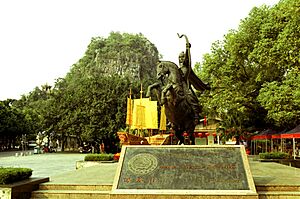
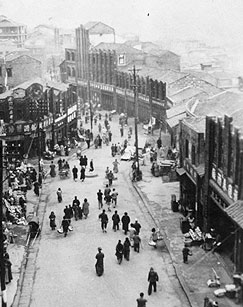
Guilin is divided into seventeen smaller areas. These include 6 districts, 8 counties, 2 special counties for different ethnic groups, and 1 county-level city.
Districts
- Xiufeng District
- Xiangshan District
- Diecai District
- Qixing District
- Yanshan District
- Lingui District
Counties and Cities
- Lipu city
- Yangshuo County
- Lingchuan County
- Xing'an County
- Quanzhou County
- Yongfu County
- Ziyuan County
- Guanyang County
- Pingle County
Autonomous Counties
- Gongcheng Yao Autonomous County (for the Yao people)
- Longsheng Various Nationalities Autonomous County (for different ethnic groups)
Guilin's Landscape and Climate
Guilin is in northern Guangxi. It shares borders with other cities in Guangxi and with Hunan province. The total area of Guilin is about 27,809 square kilometers.
Unique Karst Landscape
The land in Guilin is famous for its karst formations. These are special rock shapes made from limestone and dolomite rocks from the Triassic period. The beautiful Li River flows right through the city, adding to its stunning views.
Hills, Mountains, and Caves
Guilin has many interesting hills and mountains:
- Diecai Hill
- Elephant Trunk Hill
- Wave-Subduing Hill
- Lipu Mountains
- Kitten Mountain (the highest peak in Guangxi)
- Yao Hill
There are also famous caves to explore:
- Reed Flute Cave
- Seven-star Cave
Guilin's Weather

Guilin has a warm, wet climate. Winters are short and mild, while summers are long, hot, and humid. Spring is often cloudy and rainy. Summer is also rainy but gets the most sunshine. Autumn is usually sunny and dry.
The average temperature changes from about 8.4°C in January to 28.4°C in July. The city gets a lot of rain, especially from April to June, which can sometimes cause floods. Guilin gets about 1,487 hours of sunshine each year.
People of Guilin
In 2020, Guilin had a population of over 4.9 million people. About 2.1 million lived in the main city area.
Most people in Guilin are Han Chinese, making up about 84.5% of the population. Other large groups include the Yao (7.79%) and Zhuang (4.81%). People in the city speak a dialect of Mandarin, while those in the suburbs often speak Pinghua.
Guilin's Economy and Products
Guilin's economy includes both traditional and modern industries.
Local Industries
Some of the local industries produce things like:
- Pharmaceutical goods (medicines)
- Tires
- Machinery
- Fertilizer
- Silk
- Perfume
Before 1949, Guilin had only a few factories. But since the 1950s, it has added factories for electronics, engineering, and rubber. Food processing is still a very important industry. More recently, Guilin has developed high-tech industries and a strong tourism and service sector.
Famous Local Products
Guilin is known for its special agricultural products:
- Shatian Pomelo (a type of citrus fruit)
- Summer orange
- Fructus Momordicae (a sweet fruit)
- Ginkgo nuts
- Moon persimmon
- Lipu Taro
- Sanhua Alcohol (a type of rice liquor)
- Pepper sauce
- Fermented bean curd
- Guilin Rice Noodle
- Water chestnut
Getting Around Guilin
Guilin has good ways to travel, both by air and by land.
Air Travel
The main airport is Guilin Liangjiang International Airport (KWL). Many airlines fly to Guilin, connecting it to other cities in China and beyond.
Train Travel
Guilin has several high-speed train stations, including Guilin North, Guilin West, and Guilin Station. A new station is also in the Lingui District. These stations connect Guilin to major cities like Changsha, Beijing, Guangzhou, Shanghai, and Hong Kong. High-speed trains make it much faster and easier to visit Guilin. For example, it takes only about 2-3 hours to get from Guangzhou to Guilin.
City Transportation
Inside the city, you can travel by bus or taxi. Guilin is special because it uses double-decker buses on many of its main routes. You can also take sightseeing boats on the city's canals and lakes. There are plans for a Guilin Metro system with 7 lines and 117 stations by 2040.
Colleges and Universities
Guilin is home to several public colleges and universities:
- Guilin University of Technology
- Guilin Medical University
- Guilin University of Electronic Technology
- Guangxi Normal University
- Guilin University of Aerospace Technology
- Guilin University
Amazing Places to See in Guilin
-
The Li River connects Guilin and Yangshuo County
Guilin is famous for its beautiful natural and historical sites. Here are some popular places to visit:
- Jingjiang Princes City: A royal palace complex from the Ming dynasty in the city center.
- Reed Flute Cave: A colorful cave with amazing rock formations.
- Silver Cave: Another stunning cave to explore.
- Li River: Take a boat trip to see the famous karst mountains.
- Yangshuo: A nearby county known for its beautiful countryside.
- Seven-Star Cave and Seven Star Park: A large park with a famous cave.
- Camel Mountain and Elephant Trunk Hill: Two iconic hills that look like animals.
- Piled Festoon Hill
- Crescent Hill
- Fubo Hill
- Nanxi Hill
- Erlang Gorge
- Huangbu (Yellow Cloth) Beach
- Moon Hill: A hill with a natural archway.
- Longsheng Rice Terrace: Stunning terraced rice fields.
- Daxu Ancient Town and Xingping Ancient Town: Old towns with traditional charm.
- Duxiu, Solitary Beauty Peak
- Liusanjie Landscape Garden
- Yao Hill
- Sun and Moon Pagodas: Beautiful pagodas on a lake that light up at night.
Guilin's Delicious Food
Guilin's food mixes flavors from Cantonese cuisine and Zhuang cuisine. It's known for its tasty snacks and spicy dishes, especially using chili.
Three Treasures of Guilin
Guilin has "Three Treasures" that are very important to its food culture:
- Guilin chili sauce: Made from fresh chili, garlic, and fermented soybeans.
- Guilin Sanhua Jiu: A strong liquor made from rice.
- Guilin pickled tofu: A special kind of fermented tofu.
Guilin rice noodles are a local favorite for breakfast and have been eaten since the Qin dynasty. They are famous for their delicate taste. You can often find them with horse meat, but you can also order them without it. Another popular snack is Zongzi, a dumpling made from glutinous rice and mung bean paste, wrapped in a bamboo or banana leaf.
Famous Sayings About Guilin
People have admired Guilin's beauty for centuries.
- "I often sent pictures of the hills of Guilin which I painted to friends back home, but few believed what they saw." - Fan Chengda (a Chinese scholar from the Song dynasty)
- "Guilin's scenery is best among all under heaven." - A popular Chinese saying
Guilin's Global Connections
Guilin has "twin town" or "sister city" relationships with several cities around the world. These connections help promote friendship and cultural exchange.
Sister Cities
 – Nishikatsura, Yamanashi, Japan (with Lingchuan County)
– Nishikatsura, Yamanashi, Japan (with Lingchuan County) – Kumamoto City, Japan
– Kumamoto City, Japan – Toride City, Japan
– Toride City, Japan – Miho, Ibaraki, Japan (with Lingui)
– Miho, Ibaraki, Japan (with Lingui) – Jeju, South Korea
– Jeju, South Korea – Hastings, New Zealand
– Hastings, New Zealand – Toruń, Poland
– Toruń, Poland – Orlando, United States
– Orlando, United States – Tlaxcoapan, Hidalgo, Mexico
– Tlaxcoapan, Hidalgo, Mexico – Langkawi, Malaysia
– Langkawi, Malaysia
The relationship with Hastings, New Zealand, began in 1977. It started because both cities had similar interests, like farming and a mix of city and country life. Guilin also started an exchange program with Ōta, Gunma, Japan, in 1997.
Notable People from Guilin
Many important people have come from Guilin, including:
- Bai Chongxi: A general and politician.
- Jiang Zhenbang: A badminton player.
- Li Zongren: A general and acting president of the Republic of China.
- Ma Junwu: A scientist, educator, and politician.
- Ou Hongyi: A climate activist.
- Ouyang Xiadan: A news anchor.
- Pai Hsien-yung: A writer.
- Qiao Zhenyu: An actor and dancer.
- Shi Zhiyong: A weightlifter.
- Tang Jingsong: A general and politician.
- Daniel Weihs: An Israeli professor of aeronautical engineering.
Famous Quotes About Guilin
People have admired Guilin's beauty for a long time.
- "I often sent pictures of the hills of Guilin which I painted to friends back home, but few believed what they saw."
-
- - Fan Chengda (a Chinese scholar from the Song dynasty)
- "Guilin's scenery is best among all under heaven."
-
- - A very popular Chinese saying
See also
 In Spanish: Guilin para niños
In Spanish: Guilin para niños
- Alcoholic drinks in China
- Hạ Long Bay: A famous place in Vietnam with similar karst mountains.


